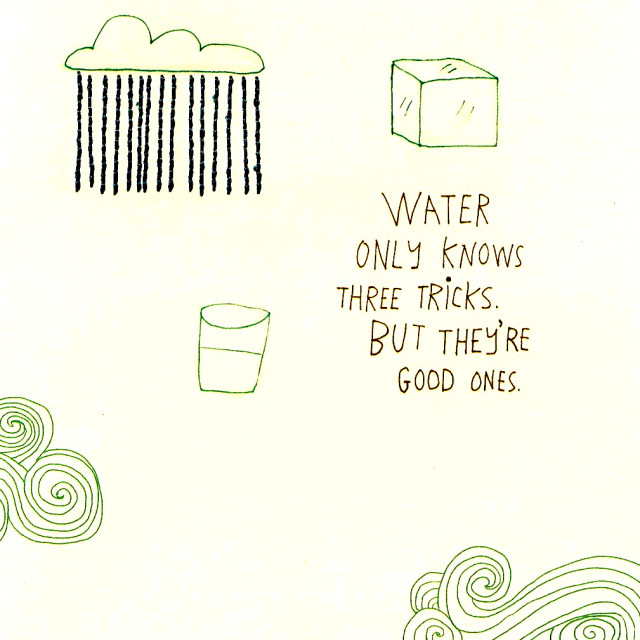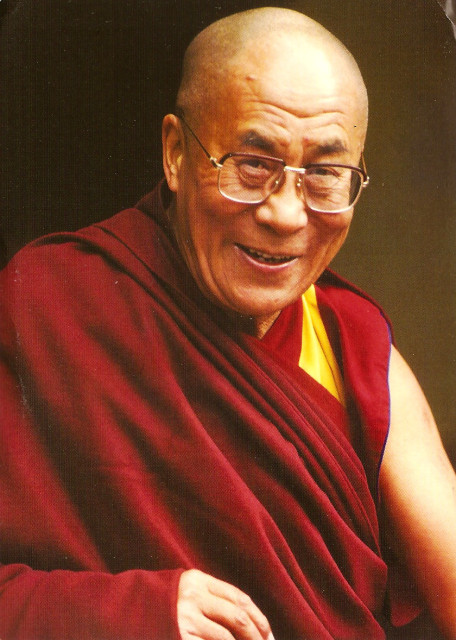“This luminous nature of the mind is not some high state, not something that you accomplish, but something that is primordial, fundamental, and essential.”
The Dalai Lama
“When we speak of freedom from negative emotion, the point is not so much to get rid of something but to dispel a mistake.” Matthieu Ricard
I have a greeting card which invites me into a contemplation of water: 
I am tickled at the clever mind that thought to transform this profound insight into a tender reminder of the not-so-solid nature of what we take to be real. It sweetly invites a journey of insight into a deeper awareness of the magic of life on planet earth: that nothing we experience IS quite exactly as it seems. Everything, influenced by infinite causes and conditions, is continually on its way to becoming something else.
Human emotion is like that, not a solid thing but an intricate and fluid weave of energy moving along our nervous systems, continually influenced by uncountable causes and conditions and designed by evolution to help us adapt quickly to our ever changing sensory experience. Within the body, emotion arises dependent on our personal DNA, our physical integrity and maturation, our levels of hormonal balance and health, and our current states like hunger and fatigue. These interact with our perceptual histories and conditioning, along with the stories we repeat to ourselves about all of these. Our bodies and minds erupt into emotion as we bump into and quickly asses internal and external sensory data as either good or not-so-good for our own wellbeing. Basic bodily emotions like desire, fear and anger help us to move toward or away quickly and without thinking. Body/mind states like love, compassion, gratitude, joy, delight, anger, fear, sadness, hurt, frustration, jealousy, embarrassment, shame, and impatience also arise in more complex ways when internal or external experience does or does not support our personal hungers, needs, wishes and goals. All of these body/mind states have associated action tendencies. Our bodies and minds know all sorts of emotional tricks, and they’re good ones.
This (and not that)
Is important
Is pleasant/unpleasant/good/bad
Get ready to act
We begin to learn and practice as babies how to regulate these emotional arousals and the resulting actions, ideally guided by the attentive presence and skill of our consistent and well-regulated caretakers. Too little emotional arousal or too much regulation leaves us at the mercy of changing internal and external conditions. Too much or too chronic emotional arousal or too little regulation leaves us overwhelmed and unable to efficiently process and act on all of the currently available information.
As we grow and begin to name things, our own mind aids this regulation as it works to organize, understand and attempt to integrate emotional arousal by naming it and then telling and re-telling stories about it. This contributes, in large part, to how we construct a sense of a personal self and it has a tendency to make emotion seem more real and solid than simply the energies of our nervous systems. Just as the union of hydrogen and oxygen molecules – in fact in continual movement through solid and fluid and vapor forms – is taken to be fixed as “rain,” or “snow” or “cloud,” so it is with emotion. Nevertheless, the flavors of body/mind movement in response to pleasant, unpleasant and neutral experience can become somewhat frozen as they are named and stored in familiar neuronal pathways. These stored patterns, in turn, increase the probabilities that the same perceptions, interpretations and emotional flavors will be triggered in the future. As they repeat and become more and more familiar, an individual can then be thought to actually be angry or happy and, further, can become identified as an angry or happy person.
From a western perspective, emotions generally are considered wholesome to the extent that their internal and external manifestations do not result in the many varieties of either internal or external harm. Organization, coherence, balance and harmony are seen as important: between and among different areas of brain functioning, between the brain and the body and between one body/mind and the external society in which it functions. Wholesomeness, here, most likely includes a sense of either the pleasant or unpleasant qualities of the experience and/or of good regulation between the arising of an internal impulse and an efficient behavioral response.
Eastern discussions generally include these aspects but then go on to focus primarily on more subtle aspects of emotion. Buddhist scholar Matthieu Ricard discusses emotion as something that conditions how the mind perceives the deepest realities. An unwholesome emotion, from this perspective, is one that disquiets and clouds the mind and prevents it from seeing clearly what is most profoundly true.
Buddhist texts describe “84,000” such unwholesome mind states: a lot. In the earliest teachings, these boil down to three basic and unwholesome roots that poison and obscure the mind and lead inevitably to human suffering: the three mind states of greed, hatred and delusion or ignorance. Ignorance is fundamental. We imagine that patterns in life have some fundamental, tangible, more or less permanent reality and we spend much energy trying to acquire and sustain more of the pleasant and to avoid or obliterate the unpleasant in an attempt to stabilize the identity and safety of our personal self. Our ignorance fails first of all to even see and then to ever more deeply accept the fluid and conditioned nature of all phenomena. Ice to water, water to gas, gas to water, water to ice in an endless and infinite stream, affected by uncounted causes and conditions which are ultimately beyond any personal agency or control.
The invitation of our spiritual practice is to practice: to come over time through presence, kindness and wholesome investigation to a personal insight into these fluid and ever changing phenomena as they arise in our direct personal experience. Through this deepening awareness, we can learn gradually to come to rest more and more in a natural wise discernment of the equilibrium and emptiness of flow itself. From that place, we can see more clearly what is a skillful action that is in harmony with the way things actually, deeply, simply are.
This process, however, is not easy or even simple. Our spiritual practice is to gradually learn to look beyond the surface appearance of things. We are invited to cultivate the capacity to see, ever more deeply, the conditioning of our minds and to come to see the fluid and conditioned nature of all reality, including our sense of a separate and independent self. With patience and insight, we can come gradually to freedom as we learn to release the insistence that life work out on our own terms.
 “When we speak of the two major aspects of this practice, namely wisdom and skillful means, they always have to work in conjunction with each other. No problem or mental affliction or destructive emotion can be dispelled by simply one thing. You always have to approach from a multitude of perspectives, a variety of mental factors, a variety of understandings. It is more complex than simply ‘there’s the problem – here’s the antidote.’
“When we speak of the two major aspects of this practice, namely wisdom and skillful means, they always have to work in conjunction with each other. No problem or mental affliction or destructive emotion can be dispelled by simply one thing. You always have to approach from a multitude of perspectives, a variety of mental factors, a variety of understandings. It is more complex than simply ‘there’s the problem – here’s the antidote.’
On a very deep level, when you actually have an unmediated realization of emptiness, that does act as an antidote to all mental afflictions. This is not to suggest that with this realization all your problems vanish with one fell swoop but it does, eventually, counteract all the mental afflictions. But in the meantime, until we reach that level, it is very important to recognize that as we counteract mental afflictions and other unwholesome tendencies, we always need to have this interplay between wisdom and skillful means.” Dalai Lama
So the invitation of these blog pages is for us to explore the 84,000 skillful means that we can use to navigate those equally numerous emotional states and through these, to find our ways individually to an ultimate and ever more complete freedom from suffering in an ever deeper understanding of what constitutes an appropriate response to this experience of human living.
